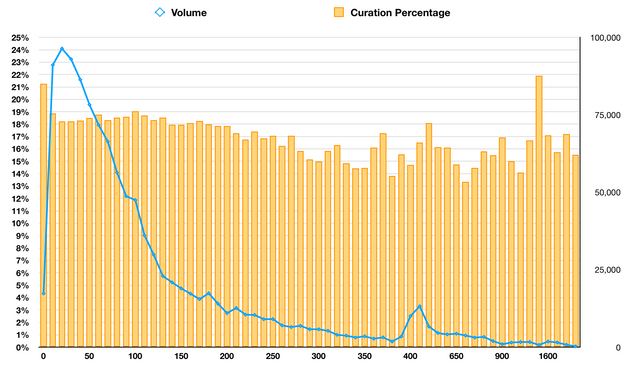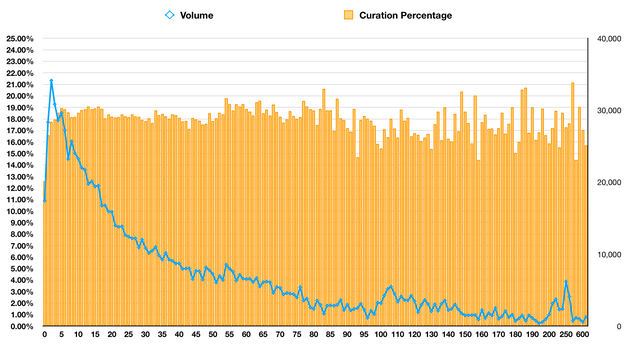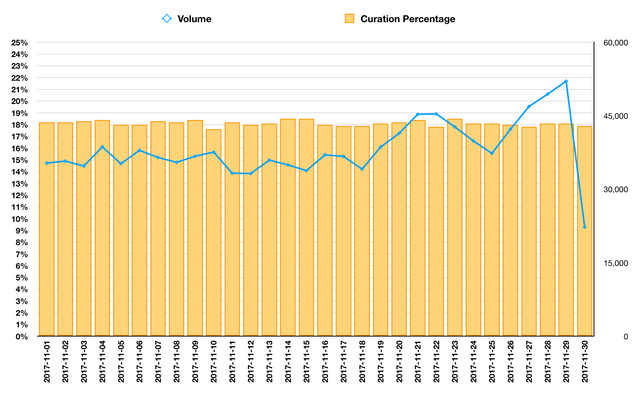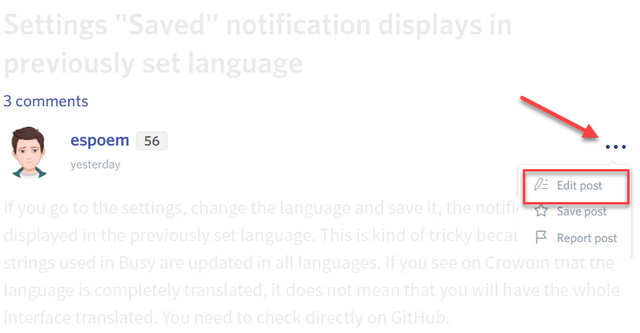Analysis of Curation Percentage by Popularity, Size of Payout, and Date
There has been a fair amount of discussion recently on whether a change is necessary to the split of author and curation rewards. A move away from 25%/75% has been mooted, with proposals of 50%/50% rewards or a sliding scale at the choice of the author or platform both gaining traction. Both proposals would require implementation within a hard fork, so the debate may be of interest to developers as well as users of the blockchain.
One point that has been raised is, given the 30 minute reverse auction period at the start of each post life returns curation rewards to the author, is our current distribution of rewards really a 25%/75% share? If not, what is the actual percentage of curation rewards distributed?
To aid in this debate I’ve drawn up a number of statistics on the current distribution of curation rewards in order to provide some backing to this debate. I won’t enter into the arguments for or against a change to the reward structure at this point.
The main statistic I am looking at is:
curation payout / ( author payout + curation payout)
I have used the data from the calendar month of November. I have excluded all posts with beneficiary payments as the reduction of the author payment can skew the above ratio. The vast majority of posts, i.e. those published on steemit.com or busy.org, have no beneficiary payments.
Headlines
- The overall curation ratio, when considering main articles (i.e. not comments) is 18.1%
- This statistic is unchanged when considering both articles and comments combined.
Analysis by popularity
I have used total net votes on a post to define popularity.
In order to maintain credible volumes for the analysis, and prevent undue volatility in the result at higher payouts, I have grouped posts together as follows:
- Posts under 400 net votes, nearest 10 votes.
- Posts under 1000 net votes, nearest 50 votes.
- Posts over 1000 net votes, nearest 200 votes.

| Net Votes (Grouped) | Volume | Curation Percentage |
|---|---|---|
| up to 50 | 462,376 | 18.5% |
| up to 100 | 290,752 | 18.6% |
| up to 500 | 349,150 | 17.4% |
| up to 5000 | 36,505 | 15.5% |
| Total | 1,138,783 | 18.1% |
- Ratios for posts up to 200 votes, where volume of payout is highest, are uniform around the 18% level.
- There is a marked drop in the curation rewards percentage for more popular posts. I would hypothesise that posts from popular authors receive a high volume of upvotes in the first few minutes of the post life, and thus return a larger percentage of rewards to the author.
- The bump in volumes at 400 net votes is just due to the way I have aggregated the data at higher levels.
Analysis by post payout
Again, in order to maintain credible volumes for the analysis, and prevent undue volatility in the result at higher payouts, I have grouped posts together as follows:
- Posts under $100 payout, nearest $1.
- Posts under $200 payout, nearest $2.
- Posts under $250 payout, nearest $10.
- Posts over $250 payout, nearest $50.

| PayoutGrouped | Volume | Curation Percentage |
|---|---|---|
| up to 50 | 777,493 | 18.2% |
| up to 100 | 221,031 | 18.5% |
| up to 150 | 80,659 | 17.3% |
| up to 10000 | 59,659 | 17.5% |
| Total | 1,138,842 | 18.1% |
- The curation ratio results are pretty uniform at post payouts up to $50, even $100, with the results close to the 18% level.
- There is a reduction in the curation percentage as post payout increases, although this is less marked than in the analysis by post popularity.
Analysis by date
For this third analysis results were grouped by date of post creation across November.

- The 18% ratio is very stable across all days.
- Post payouts have increased over the last 10 days of November due to the rising Steem price.
- Post payout volumes are low on the 30 November as some posts created on this date are still to reach vesting (these posts have been excluded from the study).
Methodology and Tools for Analysis
Raw data was obtained through sql queries of the Comments table in steemsql (thank you as always @arcange!) using Valentina Studio.
Data was analysed in Numbers, the mac spreadsheet tool.
Data was obtained across the month of November 2017.
sql query
For anyone wishing to repeat this study I have included the SQL query that I applied. (I am self-taught for SQL coding).
Query for analysis by popularity and post size
SELECT
round(comments.total_payout_value + curator_payout_value, 0) as [SumOfRoundedPayout],
round(Comments.net_votes,-1) as [RoundedNetVotes],
sum(CONVERT(REAL,Comments.curator_payout_value)) AS [SumCuratorPayoutValue],
sum(CONVERT(REAL,Comments.total_payout_value)) AS [SumTotalPayoutValue]
FROM
Comments (NOLOCK)
WHERE
YEAR(Comments.created) = 2017 AND
MONTH(Comments.created) = 11 AND
Comments.parent_author = '' and
CONVERT(REAL,Comments.pending_payout_value) = 0 and
CHARINDEX('weight', Comments.beneficiaries) = 0
GROUP BY
round(comments.total_payout_value + curator_payout_value, 0),
round(Comments.net_votes,-1)
for info: comments.total_payout_value is the author payout, not the total payout
Query for analysis by date
SELECT
convert(date, comments.created),
sum(CONVERT(REAL,Comments.curator_payout_value)) AS [SumCuratorPayoutValue],
sum(CONVERT(REAL,Comments.total_payout_value)) AS [SumTotalPayoutValue]
FROM
Comments (NOLOCK)
WHERE
YEAR(Comments.created) = 2017 AND
MONTH(Comments.created) = 11 AND
Comments.parent_author = '' and
CONVERT(REAL,Comments.pending_payout_value) = 0 and
CHARINDEX('weight', Comments.beneficiaries) = 0
GROUP BY
convert(date, comments.created)
Questions
If you have any questions or spot any errors please do not hesitate to leave a comment.
That's all for today. Thanks for reading!
Posted on Utopian.io - Rewarding Open Source Contributors
So we should change the reverse auction window to 20min?
Hey! I haven't come to any conclusions yet. I've one or maybe two more analyses to draw up looking at this area before I decide what I'll recommend. Hopefully the data will help other people to draw conclusions as well, or at least to support (or not) the arguments being made.
I would say from this analysis that it's clear 25% isn't being achieved. If that's the desired level then I think that passing curation rewards to the author in the first 30 minutes is something that shouldn't happen.
One solution is that those early curation rewards go back into the overall curation pot for other curators. This would ensure 25% is always the overall curation level.
This would also disincentivise early self-voting (I think).
That window keeps the bots in line.
If you want to disincentivize self voting, go back to the n2 and downvote abusers.
Things are this way because this benefits the rich the most, otherwise they would have listened when we objected before the hard forks were forced onto us, and they wouldnt have pounced on the reward pool like sharks.
Pretty awesome stuff again dude!
You are 'not far' from the suggested 14.9% curation at https://steemdb.com/
It's good to know we are getting a better deal than thought :)
Great!
Thanks Asher!
I think with the steemdb numbers it looks like they are percentages of all blockchain Vest rewards which includes witness payments and interest payments.
So to get the equivalent "curation ratio out of post payout" stat I think I should take just the curation and author rewards from there: 14.9%/(69.2%+14.9%) = 17.7%. So pretty close!
Quite interesting! While there does seem to be a lot of talk about changing the split, I seem to be doing well with exposing my posts and making comments that engage the poster or other commenters. I don’t have the knowledge to understand the underlying block chain structure, but it seems to me changing it would possibly create other, unforeseen problems.
I think that's my biggest concern with the proposed changes; no-one really knows how they will play out. There's a lot of game theory when changing the reward incentives. I would like to see small, and more frequent changes, one element at a time, so that we can see how each individual element acts. However I aappreciate that administratively that's a pain. Hopefully with SMTs there will be a range of reward incentives trialled, speeding up finding a solution which works best.
Thank you for the contribution. It has been approved.
You can contact us on Discord.
[utopian-moderator]
Thank you!
Your contribution cannot be approved yet as the analysis contains huge tables. Please remove these tables and instead provide graphs that may help more in analysis.
See the Utopian Rules. Please edit your contribution to reapply for approval.
You may edit your post here, as shown below:

You can contact us on Discord.
[utopian-moderator]
Hey, thanks @shreyasgune, good points.
Let me know if you think it needs anything more!
Hey @miniature-tiger I am @utopian-io. I have just upvoted you!
Achievements
Community-Driven Witness!
I am the first and only Steem Community-Driven Witness. Participate on Discord. Lets GROW TOGETHER!
Up-vote this comment to grow my power and help Open Source contributions like this one. Want to chat? Join me on Discord https://discord.gg/Pc8HG9x
hi, could you explain why i, as an author got rewarded below 75%? thanks
https://steemit.com/steemit/@bigclip/can-author-reward-goes-below-75
It will be beneficiaries. 25% of author payout on DTube, DMania, Utopian and some others plus some smaller percentages as well
.
At the moment they also have some big upvotes to give out, so swings and roundabouts.
this explains it, thanks